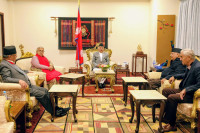Opinion
A childhood denied
We must all play our parts to end child marriage, for a better future for boys and girls
Gail Marzetti
As in most cultures, marriage is an important event in the life of the people of Nepal. It is celebrated with much tradition, pomp and happiness. Weddings quite rightly are joyous family occasions. But what if the wedding is not taking place between two consenting adults? What happens when one or both of the people getting married are children?
Robbed of childhood
Child marriage is a serious problem across the globe. According to UN estimates, around one in three young women are married before the age of 18. This number is falling compared to a generation ago. But it is still much too high.
Nepal’s law states that the minimum age for marriage for both boys and girls with parental consent is 18 years; without parental consent is 20 and that marriage should be entered into with full knowledge of what it involves. But in practice, this is not always the case. In Nepal, as per the Nepal Demographic Health Survey 2011, 41 percent of Nepali women aged 20-24 years were married before they turned 18. Every day in local newspapers, there are reports of young girls married off by their parents in rural Nepal, despite child marriage being illegal. Occasionally, children less than 18 years of age, without parental consent, are reported to be marrying by their own choice.
Bad for all
There are many reasons why child marriage is harmful. First, it is bad for girls’ health. Pregnancy damages young bodies: pregnancy-related complications are a major cause of death amongst 15-19 year olds. Because teenage mothers are not yet physically mature, their babies are also more likely to be stillborn or to die in the first weeks of infancy. Those that do survive are often smaller, and may be physically disadvantaged throughout their lives.
Second, marriage robs children of their childhood. Most children, particularly girls, stop going to school, which in turn limits their chances of getting a good job and contributing to their household. The children of uneducated mothers are less likely to go to school, reducing their chances of getting a skilled job and trapping them in poverty.
Third, child marriage also has a negative impact on young boys and men. The median age at first marriage among Nepali men as per the 2011 Nepal Demographic Health Survey is 21.6 years; traditionally, these men are expected to take full care of their wives and children. These young men are then under pressure to provide food and all kinds of financial support and they also risk missing out on educational opportunities. Many tend to take up unskilled, low-paid jobs in and outside Nepal to meet the basic needs of their family, meaning many migrating men are forced to leave behind their young wives and children.
A summit for girls
On July 22, the UK Prime Minister co-hosted the first major Girl Summit in London, with the goal of mobilising a global effort to bring an end to child marriage and female genital mutilation. At the event, governments, NGOs, faith leaders and young people came together to share their experiences and discuss what works in tackling child marriage. The Summit aimed to raise awareness of the problems of child marriage and encourage leaders to commit to change. A delegation led by Nepal’s Minister for Women, Children and Social Welfare Neelam KC Khadka also participated in the event on July 22nd. During her address to global leaders at the Summit, the minister made a pledge towards ending child marriage in Nepal. Here in Kathmandu, NGOs, government officials and academics also came together to discuss the same issues.
Right now, we know that the factors that lead to child marriage are complex and interconnected. They include poverty, a lack of education, traditional beliefs, social expectations and pressures. Ending child marriage will always involve addressing these root causes.
Education is one of the most powerful tools available. Simply by being in school, a girl is more likely to be seen as a child. Schools also provide girls with knowledge, skills, and social networks that help to raise the aspirations of both the child and her parents.
I am glad that the Government of Nepal has expressed its commitment to make Nepal free of child marriage by 2020 and that the UK’s Department for International Development is also one of the leading supporters of girls’ education and women’s empowerment in Nepal.
Currently, global attention has turned to the issue of child marriage. We have the opportunity to help make a brighter future for girls and boys. Girls themselves must be at the centre of this action—they are the ones whose rights, bodies and lives are at stake. But they alone are not responsible for creating change. All of us must play our part.
Marzetti is head of DfID-Nepal




 12.12°C Kathmandu
12.12°C Kathmandu











